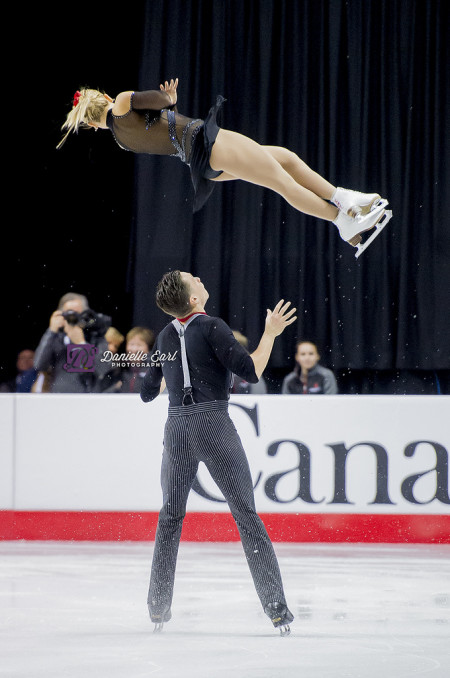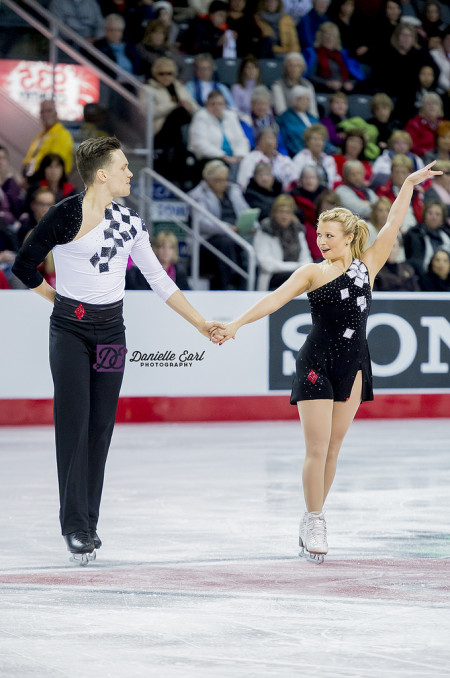by Jacquelyn Thayer
When Canadian pair Kirsten Moore-Towers and Michael Marinaro made the call to relocate from the Kitchener-Waterloo Skating Club to Bruno Marcotte and Richard Gauthier’s Montreal camp in March, the first step upon arrival was one of demolition.
“Basically when we got here, all of our elements were ripped apart,” said Moore-Towers. “So everything that we knew how to do, we were stripped of.”
This has meant trying out a side-by-side triple flip — “whether or not we do it in our program this year, we’re unsure at this point, but it is something we’d like to have in our repertoire,” she noted — along with a new triple toe-double toe-double toe combo. Revision’s come, too, in the form of a throw lutz, an alternative to their throw triple loop, along with new twist technique and fresh lifts.

Moore-Towers and Marinaro during the short program at the 2015 Canadian Tire Figure Skating Championships. Photo by Danielle Earl.
“At this point we’re pretty much running on all new elements,” she said. “It’s difficult because nothing is anything that we really are familiar with, but it’s getting a lot more comfortable as we’ve been here for just over a month now, so it’s getting a lot easier.”
“The move for us was not an easy decision by any means, for me especially,” continued Moore-Towers, who trained under Kris and Kristy Wirtz for seven years. “I think in a sense it was time for a change, and we felt like in order to grow and change as a team, we needed to be in a little bit more of a competitive environment and change up some of our technique — in essence, changes I think good for everybody at times, and this was just one of those times for us.”
Those changes will further include a new choreographic direction, as the team works for the first time with the nearby and highly in-demand Julie Marcotte for this year’s material after last year’s efforts with Vancouver-based Mark Pillay. The pair reported having just finished their short at the time of interview and were gearing up to begin on the long in the following week.
“I especially really, really enjoy working with Mark and enjoy Mark’s company in general,” said Moore-Towers, “but with Julie we see her every week. She’s here in our training base, so it’s much easier for us to have programs done by her because we can have upkeep each week, which is something that we were very much lacking last year.”
The biggest change of all for the pair may be one of sheer scope, with a crew of five coaches on hand offering specialized instruction and fresh methods which include a technological approach that Moore-Towers especially finds beneficial.
“They’re really big on videoing elements and watching over and comparing to the same element maybe done by someone else in a different way, and it’s a whole different way of learning,” she said. “It’s maybe not better or not worse — we did love training in Waterloo as well — but I feel that this style of training works better for me in particular.”
The rink at Saint-Léonard also offers a certain competitive edge. In Waterloo, the pair trained alongside a roster of younger duos, among them junior national champions and silver medalists Mary Orr and Phelan Simpson and Shalena Rau and Sebastian Arcieri. Now they join a highly international group led off by 2015 World Champions Meagan Duhamel and Eric Radford and including USA’s Marissa Castelli and Mervin Tran, Great Britain’s Caitlin Yankowskas and Hamish Gaman and fellow Canadians Natasha Purich and Drew Wolfe.
“It’s interesting to see people competing at so many different events from different countries, so there’s always something going on, someone’s always preparing for something,” said Moore-Towers. “At this point, everyone’s done with their season, so we’re all in the midst of getting new programs and working on new elements, so it’s been a very fun atmosphere for us.”
The company extends to the off-ice regimen. Where in Waterloo Moore-Towers had grown accustomed to work with a private trainer and Marinaro to a gym setting, here group activity is more central, with most senior couples sharing a trainer.

Moore-Towers and Marinaro during the long program at the 2015 Canadian Tire Figure Skating Championships. Photo by Danielle Earl.
“We go to the gym and they have a computer open, and each skater has their own file with their own workout,” said Moore-Towers. “So it’s kind of the best of both worlds, because you complete your own workout that’s specific to your needs while doing it in a group setting and being supported by your training mates. Everybody is hurting and everybody is working hard, so it’s nice to do it in a group setting while doing your own thing or something you feel that is specific to you.”
Additional off-ice pursuits include Pilates and Essentrics, a class introduced to the duo by Duhamel. “It’s a mix of a little bit of yoga, Pilates, ballet and stretching, but it’s a way to move your body to really prevent injury and elongate your muscles and stretch out the space between your bones,” said Moore-Towers.
Despite the proximity in competitive level between many teams, the pair agree that the atmosphere is a deeply positive one.
“It really is a happy and productive place,” said Moore-Towers. “The attitude is kind of ‘if they’re doing better, they’re going to push us to be better,’ and we learn from them. We watch Meagan and Eric in most of the things they do and try to study how they do it and how we can do it more like them because they are, literally, the best in the world at this point and so we can only get better from watching them.”
Moore-Towers and Marinaro’s central focus, indeed, is one of improving upon a sometimes difficult debut season, which saw the team finishing 0.95 points off the national podium and navigating the international circuit in the midst of a new pair’s typical learning curve. And while supportive of her former partner’s own successes last season, Moore-Towers noted the particular challenges of competing against Dylan Moscovitch with new partner Lubov Iliushechkina.
“The year was awkward and tricky and of course, we were trying to learn our rhythm as a team and trying to figure out who we were as people and who we were going to be together,” said Moore-Towers. “And I just felt like there wasn’t really much time to figure out the elements, much less have refined programs, and so that’s where I felt personally we were lacking. Which I think was another reason for a move — we felt like here there would be a lot of focus on our components and on maximizing our levels, and as we have been here for a month, it really has proven to be the case.”
With the effort required to make a fresh start on the ice, there’s little time to spare away from it.
“The running joke is a week for me is all about survival,” said Moore-Towers. “I skate and work out and then usually have an ice bath or an ice pack in the hot bath and then just try to rest and hang out with my dog.”
“Recovery and it’s 99 percent training right now,” agreed Marinaro.
On weekends, though, Marinaro, already close with some of the other pairs men, enjoys the chance to kick back with training mates, as does Moore-Towers. And Moore-Towers has also taken to exploring Montreal with one constant companion — dog Lyla.
“She loves it here,” she said. “I’ve had a lot of fun taking her to different kind of dog parks and we found a doggie café here where dogs can roam around in the café while I get whatever I need to get done or read a book or drink tea or whatever, so it’s definitely been fun in a bigger city because there’s so much more dog activity.”
Amid the intensity of the new, the team is finding the rewards well worth the adjustment.
“Especially since we’ve been here, I find we have little breakthroughs all the time,” said Moore-Towers. “The second week we were here, I actually called my mom and said ‘Oh my goodness, this is how it’s supposed to be.’”
